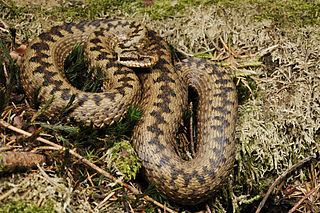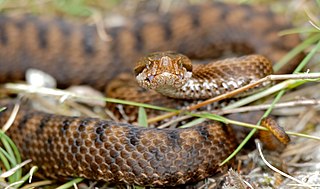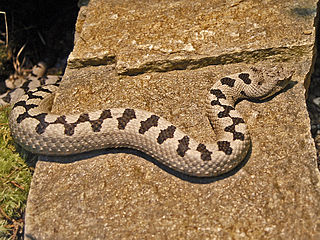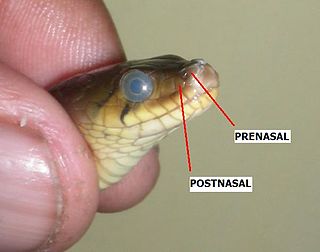Related Research Articles

The eastern copperhead, also known as the copperhead, is a species of venomous snake, a pit viper, endemic to eastern North America; it is a member of the subfamily Crotalinae in the family Viperidae.

Agkistrodon piscivorus is a species of pit viper in the subfamily Crotalinae of the family Viperidae. It is one of the world's few semiaquatic vipers, and is native to the southeastern United States. As an adult, it is large and capable of delivering a painful and potentially fatal bite. When threatened, it may respond by coiling its body and displaying its fangs. Individuals may bite when feeling threatened or being handled in any way. It tends to be found in or near water, particularly in slow-moving and shallow lakes, streams, and marshes. It is a capable swimmer and, like several species of snakes, is known to occasionally enter bays and estuaries and swim between barrier islands and the mainland.

Keeled scales refer to reptile scales that, rather than being smooth, have a ridge down the center that may or may not extend to the tip of the scale, making them rough to the touch. According to Street's (1979) description of European lizards and snakes, in those that have keeled scales the keels are usually stronger in male specimens and are consistently arranged according to the species of reptiles, even though many others do not have them. With European lizards, the dorsal scales are usually well keeled, while those on the flanks are more weakly keeled and those on the belly smooth. Non-European lizards such as Sphaerodactylus macrolepis also display keeled scales.

Vipera berus, the common European adder or common European viper, is a venomous snake that is extremely widespread and can be found throughout most of central and eastern Europe and as far as East Asia.

Russell's viper is a venomous snake in the family Viperidae native to the Indian subcontinent and one of the big four snakes in India. It was described in 1797 by George Shaw and Frederick Polydore Nodder, and named after Patrick Russell, who wrote about it in his 1796 work An account of Indian serpents, collected on the coast of Coromandel.

The eastern diamondback rattlesnake is a species of venomous pit viper in the family Viperidae. The species is endemic to the Southeastern United States. It is one of the heaviest venomous snakes in the Americas and the largest rattlesnake. No subspecies are recognized.

Heterodon is a genus of harmless colubrid snakes endemic to North America. They are stout with upturned snouts and are perhaps best known for their characteristic threat displays. Three species are currently recognized. Members of the genus are commonly known as hognose snakes, sand viper, hog-nosed snakes, North American hog-nosed snakes, and sometimes puff adders.

Echis is a genus of venomous vipers found in the dry regions of Africa, the Middle East, India, Sri Lanka and Pakistan. They have a characteristic threat display, rubbing sections of their body together to produce a "sizzling" warning sound. The name Echis is the Latin transliteration of the Greek word for "viper" (ἔχις). Their common name is "saw-scaled vipers" and they include some of the species responsible for causing the most snakebite cases and deaths in the world. Twelve species are currently recognized.

Azemiopinae is the name of a monogeneric subfamily created for the genus Azemiops that contains the venomous viper species A. feae and A. kharini. No subspecies are recognized. The first specimen was collected by Italian explorer Leonardo Fea, and was described as a new genus and new species by Boulenger in 1888. Formerly considered to be one of the most primitive vipers, molecular studies have shown that it is the sister taxon to the pit vipers, Crotalinae. It is found in the mountains of Southeast Asia, in China, southeastern Tibet, and Vietnam. Common names are Fea's vipers.

Vipera aspis is a venomous viper species found in southwestern Europe. Its common names include asp, asp viper, European asp, and aspic viper, among others. Bites from this species can be more severe than from the European adder, V. berus; not only can they be very painful, but also about 4% of all untreated bites are fatal. The specific epithet, aspis, is a Greek word that means "viper." Five subspecies are currently recognized, including the nominate subspecies described here.
In snakes and amphibians, the canthus, canthal ridge or canthus rostralis, is the angle between the flat crown of the head and the side of the head between the eye and the snout, or more specifically, between the supraocular scale and the rostral scale. It is defined as a sharp ridge in many viperids, but is rounded in most rattlesnakes, for example.

Vipera transcaucasiana is a venomous viper species endemic to parts of Georgia and northern Turkish Anatolia.

Snakes, like other reptiles, have skin covered in scales. Snakes are entirely covered with scales or scutes of various shapes and sizes, known as snakeskin as a whole. A scale protects the body of the snake, aids it in locomotion, allows moisture to be retained within, alters the surface characteristics such as roughness to aid in camouflage, and in some cases even aids in prey capture. The simple or complex colouration patterns are a property of the underlying skin, but the folded nature of scaled skin allows bright skin to be concealed between scales then revealed in order to startle predators.

In reptiles, the nasal scale refers to the scale that encloses the nostril.
The mental scale, or mental, in snakes and other scaled reptiles refers to the median plate on the tip of the lower jaw. It is a triangular scale that corresponds to the rostral of the upper jaw. The reference to the term 'mental' comes from the mental nerve which addresses the chin and lower jaw in animals. In snakes, the shape and size of this scale is sometimes one of the characteristics used to differentiate species from one another.
In scaled reptiles, the ocular scales are those forming the margin of the eye. The name originates from the term oculus which is Latin for 'eye' and, in the broadest sense, refers to a scale associated with the eye. The numbers of these scales present, and sometimes the shapes and sizes, are some of many characteristics used to differentiate species from one another.

In snakes, the anal scale is the scale just in front of and covering the cloacal opening. This scale can be either single or paired. When paired, the division is oblique. The anal scale is preceded by the ventral scales and followed by the subcaudal scales.

Agkistrodon contortrix mokasen was formerly a venomous pit viper subspecies found in the eastern United States. However, recent taxonomic changes do not recognize the northern copperhead as a valid taxon.
Brachyophis is a monotypic genus created for the rear-fanged venomous snake species, Brachyophis revoili, commonly known as Revoil's short snake, which is endemic to Eastern Africa. Three subspecies are recognized as being valid.

Atractaspis aterrima, commonly known as the slender burrowing asp or mole viper, is a species of fossorial, venomous snake in the family Atractaspididae. The specific epithet, aterrima, meaning "blackest", is the superlative form of the Latin adjective ater, meaning "black".
References
- ↑ Mallow D, Ludwig D, Nilson G. 2003. True Vipers: Natural History and Toxinology of Old World Vipers. Malabar, Florida: Krieger Publishing Company. 359 pp. ISBN 0-89464-877-2.
- ↑ Wright AH, Wright AA. 1957. Handbook of Snakes. Comstock Publishing Associates (7th printing, 1985). 1105 pp. ISBN 0-8014-0463-0.